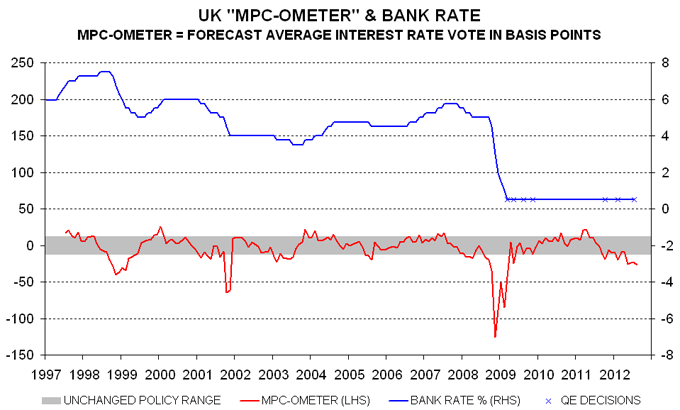The Monetary Policy Committee is likely to stand pat at next week’s meeting but the “MPC-ometer” model used here to forecast decisions remains firmly in the easing zone, suggesting further action – probably in the form of a cut in Bank rate – over coming months.
The MPC-ometer predicts the monthly policy decision based on the latest values of 12 economic and financial inputs, including business / consumer confidence measures, GDP growth, inflation, wage increases, measures of price expectations, credit spreads and the stock market. Since its introduction in 2006, the model’s forecasting record has compared favourably with the consensus prediction of the monthly Reuters interest rate poll, with periodic “misses” generally due to it moving before the MPC – the model, for example, signalled that “QE3” was likely as early as May.
The model’s output is in the form of the forecast average interest rate vote* of MPC members, with readings of above +12.5 or below -12.5 basis points suggesting a rise or cut respectively in Bank rate. Since Bank rate reached an effective lower bound in early 2009 – at least as judged by the MPC until recently – undershoots of the -12.5 threshold have signalled expansions of QE. The historical performance of the model (estimated on the full data set) is shown in the chart – movements out of the shaded “neutral” zone are usually associated with Bank rate changes or QE announcements.
The last data point in the chart is an August estimate based on data for two-thirds of the inputs and assumptions that 1) tomorrow’s second-quarter GDP estimate shows a fall of about 0.5% (i.e. consistent with a flat economy adjusting for the Diamond Jubilee bank holiday) and 2) components from business and consumer surveys released around month-end are unchanged. The result is another reading below the -12.5 threshold, suggesting further policy easing.
Such action is unlikely next week. The MPC will not wish to amend the announced QE3 programme so soon and will also need time to assess the stimulative impact, if any, of the “funding for lending” scheme (FLS) – the model forecast does not take account of this additional initiative (though will if it translates into improvements in the components, e.g. narrower credit spreads or a recovery in business confidence). The suggestion, however, is that the MPC will be prepared to move again in September if economic and financial indicators remain at current levels.
The most likely next step is a cut in Bank rate to 0.25%. The MPC was previously concerned that this would damage credit supply by squeezing banks’ net interest margins but the cheap funding offered through the FLS is now expected to have an offsetting impact. The possibility of a Bank rate reduction has also been opened up by the ECB’s decision to lower its deposit rate to zero (and official musings about the imposition of a negative rate); this has contributed to recent upward pressure on sterling versus the euro. The MPC, in theory, could lower the rate paid on reserves without cutting Bank rate – thereby protecting banks’ interest income from tracker mortgages – but this looks too complicated and would further weaken linkages between the official rate and market rates.
*For example, if five members want to raise official rates by 25 basis points while four prefer no change, the weighted-average vote is +14 (five-ninths of 25).
